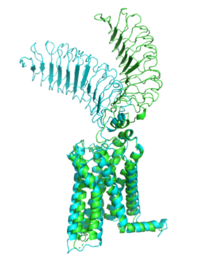Sandbox Reserved 1780
From Proteopedia
(Difference between revisions)
| Line 15: | Line 15: | ||
[[Image:Agonist pic.png|450 px|right|thumb|Figure 2: Agonist and antagonist drugs for activating or inactivating the TSHR protein.]] | [[Image:Agonist pic.png|450 px|right|thumb|Figure 2: Agonist and antagonist drugs for activating or inactivating the TSHR protein.]] | ||
| - | |||
| - | |||
| - | |||
| - | |||
| - | |||
| - | </StructureSection> | ||
| - | == References == | ||
| - | <references/> | ||
| - | |||
==Introduction== The Thyroid-stimulating hormone receptor (TSHR) is a G protein-coupled receptor (GPCR) that plays a crucial role in regulating the function of the thyroid gland. TSHR is a transmembrane receptor located on the surface of thyroid follicular cells, which are responsible for producing thyroid hormones. TSHR is activated by Thyroid-stimulating hormone (TSH) and triggers a signaling cascade that results in the production and secretion of thyroid hormones. Dysregulation of TSHR can lead to a variety of thyroid disorders, including hyperthyroidism and hypothyroidism. | ==Introduction== The Thyroid-stimulating hormone receptor (TSHR) is a G protein-coupled receptor (GPCR) that plays a crucial role in regulating the function of the thyroid gland. TSHR is a transmembrane receptor located on the surface of thyroid follicular cells, which are responsible for producing thyroid hormones. TSHR is activated by Thyroid-stimulating hormone (TSH) and triggers a signaling cascade that results in the production and secretion of thyroid hormones. Dysregulation of TSHR can lead to a variety of thyroid disorders, including hyperthyroidism and hypothyroidism. | ||
| Line 32: | Line 23: | ||
==Function== The TSHR protein plays a critical role in regulating the production and secretion of thyroid hormones. When TSH binds to TSHR on the surface of thyroid follicular cells, it activates a signaling cascade that leads to the production and secretion of thyroid hormones. This process is regulated by a negative feedback loop, where increased levels of thyroid hormones in the bloodstream inhibit the production and secretion of TSH from the pituitary gland. | ==Function== The TSHR protein plays a critical role in regulating the production and secretion of thyroid hormones. When TSH binds to TSHR on the surface of thyroid follicular cells, it activates a signaling cascade that leads to the production and secretion of thyroid hormones. This process is regulated by a negative feedback loop, where increased levels of thyroid hormones in the bloodstream inhibit the production and secretion of TSH from the pituitary gland. | ||
==Clinical significance== Dysregulation of TSHR can lead to a variety of thyroid disorders. Hyperthyroidism, a condition characterized by an overactive thyroid gland, can be caused by the overstimulation of TSHR by TSH or TSHR agonists. This can result in an excess of thyroid hormones in the bloodstream, leading to symptoms such as weight loss, rapid heartbeat, and tremors. Hypothyroidism, a condition characterized by an underactive thyroid gland, can be caused by the decreased stimulation of TSHR by TSH. This can result in a deficiency of thyroid hormones in the bloodstream, leading to symptoms such as fatigue, weight gain, and cold intolerance. In addition, mutations in the TSHR gene can lead to inherited thyroid disorders. | ==Clinical significance== Dysregulation of TSHR can lead to a variety of thyroid disorders. Hyperthyroidism, a condition characterized by an overactive thyroid gland, can be caused by the overstimulation of TSHR by TSH or TSHR agonists. This can result in an excess of thyroid hormones in the bloodstream, leading to symptoms such as weight loss, rapid heartbeat, and tremors. Hypothyroidism, a condition characterized by an underactive thyroid gland, can be caused by the decreased stimulation of TSHR by TSH. This can result in a deficiency of thyroid hormones in the bloodstream, leading to symptoms such as fatigue, weight gain, and cold intolerance. In addition, mutations in the TSHR gene can lead to inherited thyroid disorders. | ||
| - | |||
| - | |||
==References== {{reflist|30em}} | ==References== {{reflist|30em}} | ||
==External links== *[https://proteopedia.org/wiki/index.php/TSH_Receptor TSH Receptor] on Proteopedia. | ==External links== *[https://proteopedia.org/wiki/index.php/TSH_Receptor TSH Receptor] on Proteopedia. | ||
[[Category:Proteins]] [[Category:G protein-coupled receptors]] | [[Category:Proteins]] [[Category:G protein-coupled receptors]] | ||
| + | |||
| + | |||
| + | |||
| + | |||
| + | </StructureSection> | ||
| + | == References == | ||
| + | <references/> | ||
Revision as of 03:39, 30 March 2023
| This Sandbox is Reserved from February 27 through August 31, 2023 for use in the course CH462 Biochemistry II taught by R. Jeremy Johnson at the Butler University, Indianapolis, USA. This reservation includes Sandbox Reserved 1765 through Sandbox Reserved 1795. |
To get started:
More help: Help:Editing |
| |||||||||||


